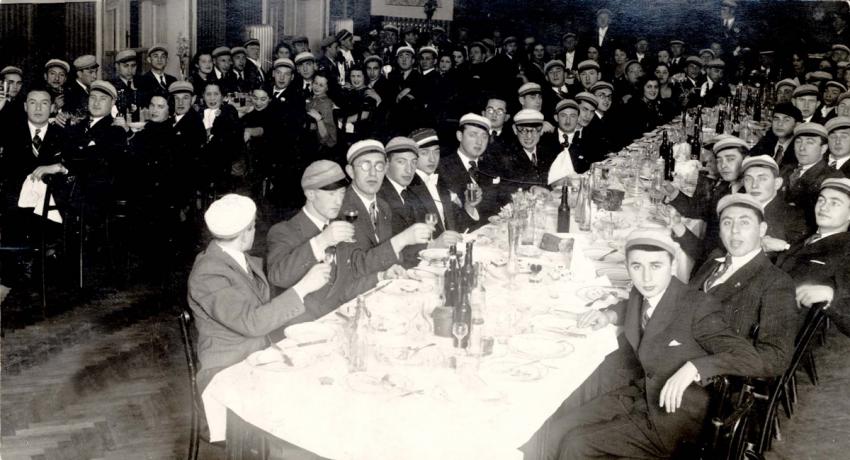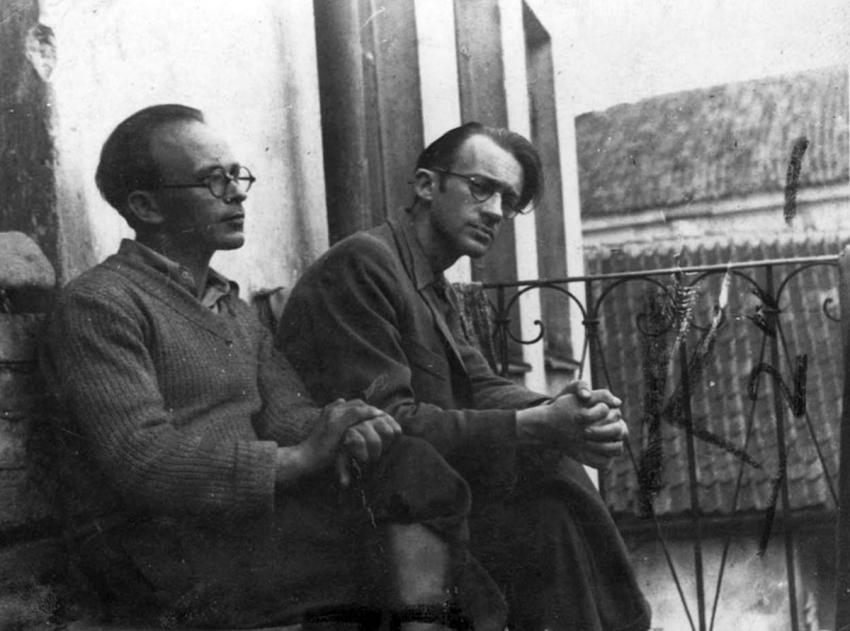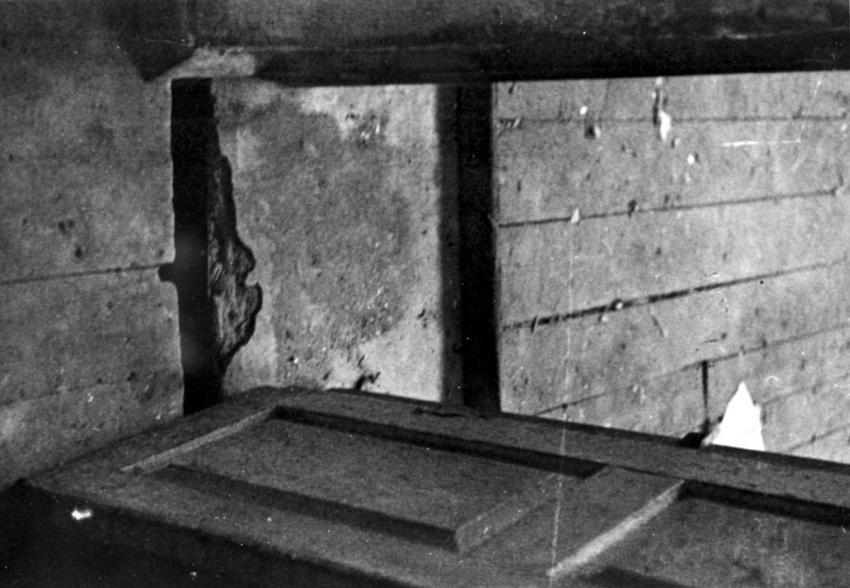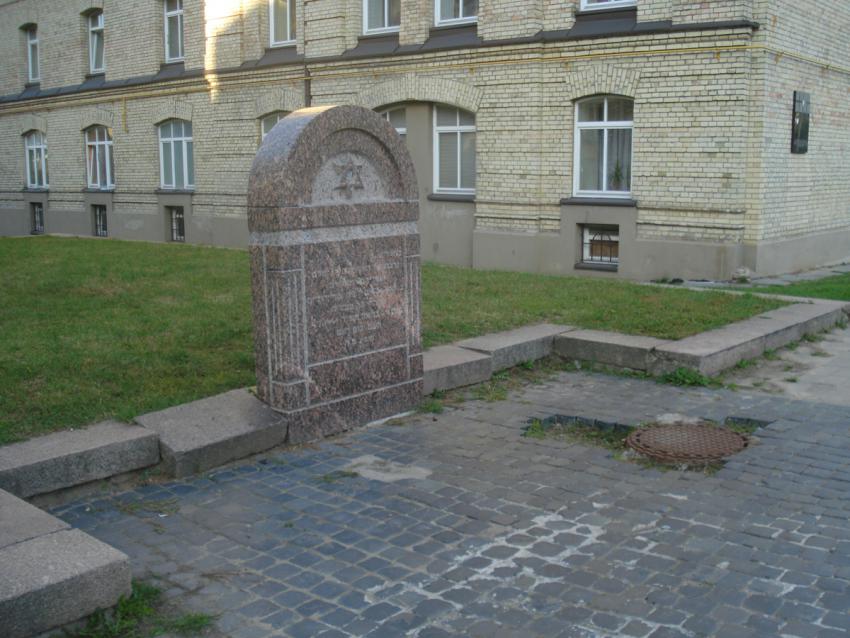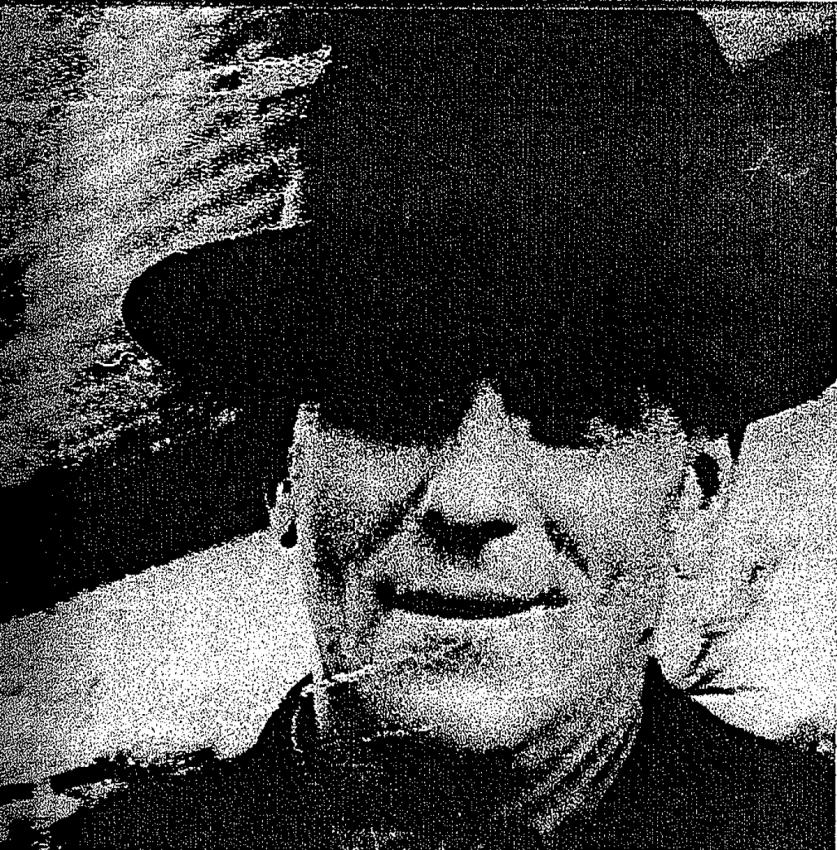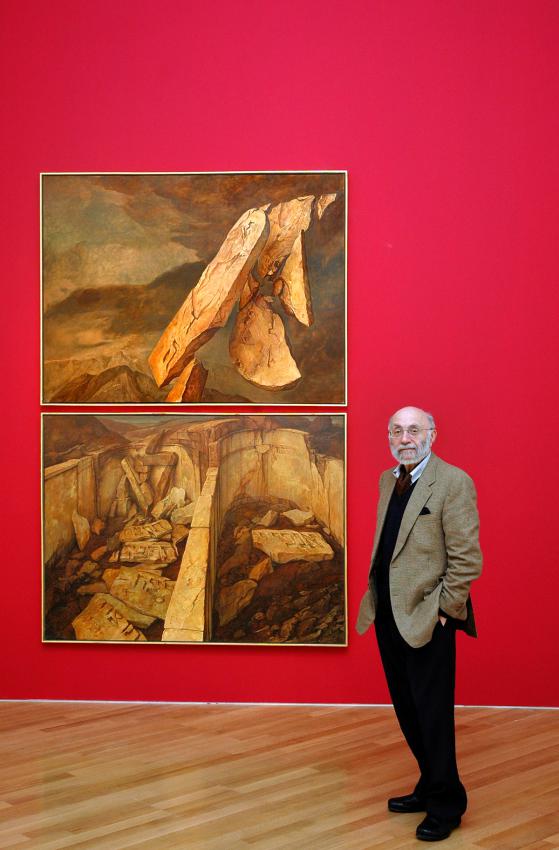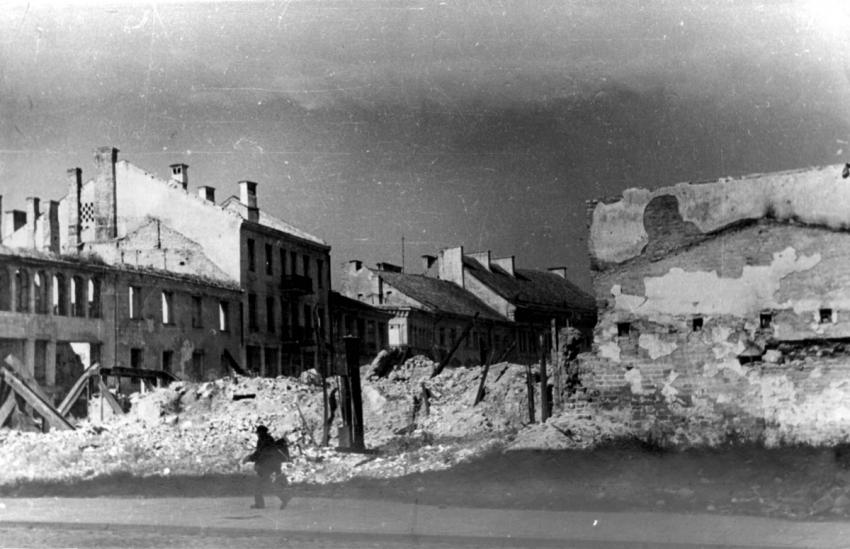In this teacher's guide, we explore one aspect of the tragic history of the Jews in Vilna during the Holocaust: the widespread attempts at survival by hiding, both inside and outside the ghetto. These hiding places became known colloquially as “malinas”. We approach the phenomenon through a composite of four examples of hiding, both outside the ghetto, as with the cases of Rubin Schneider's malina and Samuel Bak's hiding at the Benedictine convent, and inside the ghetto - with the malinas at 6 Rudnicka St. and at 19 Germans St.
Unit contents:
- Introduction and Overview
- Vilna - “Jerusalem of Lithuania” - Malinas - Overview
- Malinas inside the Ghetto
- Mendel Balberyszski - The Malina on 6 Rudnicka Street
- The Malina on 19 Germans Street - Malinas outside the Ghetto
- Hiding at the HKP Labor Camp
- Rubin Schneider’s Malina
- Samuel Bak’s Family - The Benedictine Convent - Conclusion and General Discussion
Introduction
IntroductionIn this teaching unit, we explore one aspect of the tragic history of the Jews in Vilna during the Holocaust: the widespread attempts at survival by hiding, both inside and outside the ghetto. These hiding places became known colloquially as “malinas”, and by several accounts were especially developed in Vilna during the German occupation. Although the overwhelming majority of Vilna’s Jews would perish in the Holocaust, the phenomenon of seeking hiding represents an integral part of the lives of many Jews interned in Vilna’s ghettos.
As this unit will focus on individual instances of hiding, we recommend the teacher at least read the “expanded topic” selections and present them, in order to contextualize these hiding attempts with the unfolding historical events.
After providing an overview of Vilna Jews’ fate, we present four case studies of Jews in hiding. These examples together form a kind of composite of the experience of attaining, and then being in, hiding.
- The teacher can present all four or any combination, to deepen our understanding of the reality of Vilna Jews, at different points and locations, during the Holocaust.
- Relevant discussion questions are available within each case study, as well as general discussion questions at the concluding section.
Vilna - “Jerusalem of Lithuania”
On the eve of the Holocaust the Jewish community of Vilna was the spiritual center of Eastern European Jewry. It was a center of enlightenment and Jewish political life, of Jewish creativity and the experience of daily Jewish life, a community bursting with cultural and religious life, movements and parties, educational institutions, libraries and theatres; a community of religious scholars and rabbis, intellectuals, poets, authors, artists, craftspeople and educators. In the Jewish world it was known as "The Jerusalem of Lithuania" – a spiritual center of the first order.
[Expanded topic: Prewar Jewish Vilna - Culture, Politics, Education, and Institutions]
In July 1940 Vilna was annexed to the Soviet Union, following their invasion from the east in accordance with an agreement with Nazi Germany. On June 22, 1941, the Germans invaded Soviet territory, entering Vilna on June 24th. Some 57,000 Jews were living in Vilna at the time.
The Holocaust in Vilna
Following the occupation, German persecution of Jews began almost immediately. Some 60 Jews were taken hostage in Lukiszki prison, and most were murdered weeks later. Two days after the occupation, Jewish men began being conscripted, often violently, for forced labor. In July, some 5,000 Jewish men were taken forcefully and murdered at a large mass murder pit at Ponar (Ponary) Forest.
[Expanded topic: Ponar]
In September 1941 two ghettos were established, into which the Jews of Vilna and the surrounding areas were forced to move. Over the course of the following months the Germans, with the assistance of Lithuanian units, forcefully took tens of thousands of Jews to be murdered in a series of brutal Aktionen (deportations). In a pattern that would be followed in other ghettos, the Germans issued Jews limited numbers of work permits (“Sheinen”), which usually allowed its bearers and their families to avoid the deportations, and then successively cancelled and issue new permits, each time for smaller numbers. By the end of 1941, some 33,500 Jews had been murdered, and the smaller ghetto had been liquidated.
For a little over a year - from January 1942 to March 1943 - the widespread murder ceased, though sporadic murder continued. The Jews of the Vilna ghetto contended with extreme hardships - hunger, limited and undersupplied public services (medicine, social aid, housing, etc.), extremely cramped conditions, and acute uncertainty as to what the future holds.
[Expanded topic: Vilna during the Holocaust]
Nevertheless cultural life in the ghetto thrived. In April 1943, shortly after the widespread murder resumed, Zelik Kalmanovitch wrote, “The cultural efforts continue unabated: plays at the theater, choirs, . . . an orchestra, the youth movement, lectures for the workers every Sunday, lectures by the doctors, Hebrew class, authors write articles and receive assistance, the youth draws, the sports field has been restored.“ The library at one point celebrated the lending of its 100,000th book; literature and poetry contests took place; schooling for the children continued wherever possible - and as we will see, even in near-impossible conditions.
The mass murders resumed during the spring and summer of 1943. During August-September thousands were deported to camps, most of them in Estonia, and some in Latvia. The ghetto was liquidated on the 23rd and 24th of September, 1943. Shortly before the liquidation, some 350 Jewish workers in the HKP vehicle repair workshops were moved out of the ghetto, along with their families, as well as some workers of the “Kailis” fur and leather factory.
[Expanded topic: The end of the Vilna Ghetto]
Malinas - Overview
Malinas - Overview“Yesterday the most dreadful news has been brought into the ghetto. . . . A rumor circulated that Himmler issued an order to destroy all the Jews of Europe . . .
The conclusion – Malinas.”
1
- Herman Kruk, Vilna Ghetto, November 26, 1942
“The malina became so well known, that it began to be used in all kinds of ways [in speech]: ‘We must malina (ourselves),’ ‘you’re a good maliner.’ ‘I lay malina’d.’ When the teacher, Stolicki’s, wife bore a child in a malina, she named him ‘malina’.”
2
- Abraham Sutzkever
For the Jews still living in the ghetto, the swift and widespread mass murders brought a profound sense of chaos and fear. The danger of sudden inclusion in an aktion - or just random murder - was ever-present. In this environment, some Jews took to constructing hiding places, colloquially known as “malinas” (singular “malina” or “melina”). Before the war, the term came from criminal slang, designating hiding places from the authorities. The first malinas were constructed as early as July 1941.
The malinas in Vilna were a particularly widespread phenomenon. As historian Yitzhak Arad writes,
“The malina in the ghetto was the chief instrument in rescuing thousands who had not secured passes and were unable to “attach” themselves as “dependents.” Some malinas were large enough for only one person – chimneys, ovens, double-partitioned cupboards or closets; others were large enough to hold tens of hundreds of people-basements, garrets, rooms, and even apartments with camouflaged doors. The high stone buildings and the housing congestion in the ghetto offered many likely places for concealment in well-devised malinas and enabled the practice to be developed on a large scale. Thousands of people invested their initiative, imagination, and hard labor for weeks and months to prepare malinas, for they required ventilation, water, and food. [..]
Thousands who sought rescue in these coverts could hide for several days during the house-to-house searches and then emerge and continue to live openly until the next Aktion.”
Yitzhak Arad, Ghetto in Flames: The Struggle and Destruction of the Jews in Vilna in the Holocaust (Israel: Yad Vashem, 1980), pp. 192-193.
Arad estimates thousands sought shelter in malinas during the period of German occupation. As Mark Dworzecki recalled,
“A whole art developed in this kind of building. [..] Malinas were built in attics, basements, beneath old buildings, under garbage cans, beneath bathrooms, inside chimneys, beneath wells, in caves. [..] In most cases malinas were shared, since a group effort was required to attain the necessary building materials, the space, and the [skilled] people to construct such a malina.“
Mark Dworzecki, Jerusalem of Lithuania in Revolt and Holocaust [Hebrew], (Tel Aviv: Workers Party of Israel, 1951), p. 72.
Later, when it became more apparent to the remaining survivors that malinas would not save them in the ghetto, some malinas were extended out of the ghettos, or into the sewer system, with tunnels.
- Herman Kruk, The Last Days of the Jerusalem of Lithuania, (New Haven and London, Yale University Press & YIVO Institute for Jewish Research, 2002), p. 419-420.
- Abraham Sutzkever, The Vilna Ghetto [Hebrew], (Tel Aviv: Shechvi 1947), p. 114.
Malinas Inside the Ghetto
Malinas Inside the Ghetto“Inside the malinas . . . one hears the unrelenting sounds of the Germans walking above. Almost in one’s body, one feels the echo of their heavy boots, shaking, terrified, at the sound of pickaxes, with which the Lithuanians are breaking the walls. Ceaseless anticipation, and unbearable tension, and longing for a miracle to occur.“
Reizl Korchak, Flames in the Ashes, 3rd ed. [Hebrew], (Tel Aviv: Sifriat Poalim, 1965), p. 42-43. - Reizl Korchak
“In those days, life in the ghetto became a nightmare. People hiding in various locations, sometimes between double walls, were cramped in suffocating positions, with no air, food or water, trembling lest they be discovered and sent to their deaths.”
Gregory Shurr, Notes from the Vilna Ghetto [Hebrew], (Tel Aviv: Association of Jews from Vilna and the Vicinity in Israel), p. 42. - Gregory Shurr
1. Mendel Balberyszski - The Malina on 6 Rudnicka Street
In November 1941 Mendel Balberyszski, who had been a leading communal personality in prewar Poland, had not been issued a work pass, an almost sure sign of inclusion in an Aktion - forced deportation, usually to be murdered. The situation spelled death for him and for his wife, Leah, their children Deborah and Theodore, and his mother Liba. On the eve of an impending (second “yellow-pass”) deportation, Balberyszski described going into hiding in a malina:
"It was nighttime. I called my family together and we took the few things left in our possession and went with the administrator. We entered the third court of 6 Rudnicka [Street]. . . . We went along the court and entered a narrow passage leading to an apartment. The door of the apartment was not locked and we entered. We found ourselves in a small kitchen which opened into a room full of old-fashioned furniture. In the center of the room stood a large wardrobe that divided the room in two. We entered behind the wardrobe and looked bewildered. We were facing a wall with a built-in cupboard and there was nowhere to go. . . .
[An] elderly man came forward, opened up the cupboard doors wider and said: “well, bend down and go." I bent down as ordered. Only then did I understand what he meant. The opening was so low that I had to slide in on my belly. . . . When we were all in, the man on the outside covered the opening with a board, threw some rags and papers on the shelf and closed the doors of the cupboard.
When we rose from the floor we were blinded by the bright light. We found ourselves in a large room full of furniture, mostly beds. . . . The room had large windows, but the inner shutters had been closed and outside the windows had been boarded up. Heavy drapes had been placed on top of the inner shutters not to let a single ray of light stray outside. Any light in the room came from the electric light bulbs. . . .
Near the entrance hole stood a large brass bed and next to it a small table. On that bed Mrs. Kremer and her daughter Nadia with a small boy had their ‘home.’ . . . Mr. Kremer slept in another comer of the room on a sofa. Next to the brass bed on the other side stood another cupboard and next to it a metal bed without a mattress. The bed became the ‘home’ of my wife and daughter. . . .
We were overjoyed with the new place. For the last twelve days we had been roaming the streets of the Ghetto like stray dogs, in attics, in dirt, we could not remove our overcoats and now we were among people we knew who received us warmly. For the first time we had the opportunity to go into another room that had once been a locksmith’s workshop, remove our clothes and wash ourselves. . . .
No matter how difficult the situation was, nor how hard and bitter our life became with the permanent fear of being discovered during the murderous ‘cleansing’ actions, we felt very relieved to have found that wondrous place. . . .
As the room had no open doors or windows, the light remained on day and night. Meals were cooked — if ever — in electric pots and water boiled in electric kettles. . . . Our neighbors advised us to go out as little as possible in order not to jeopardize the security of the hideout. We decided that only my mother would leave the place to buy food. All others were to remain inside.”
Mendel Balberyszski, Stronger than Iron, The Destruction of Vilna Jewry 1941-1945: An Eyewitness Account (Jerusalem: Gefen Publishing House, 2010), pp. 170-174;177.
On the eve of the November 1941 “Yellow Pass” deportation to be murdered, Balberyszski describes the atmosphere and the decision made in the malina:
“[W]e could not make peace with the thought that this might be the last night that we would be together and among friends. Early in the morning we were awakened by a very strong noise at our door — the hole in the wall. Chaim Bakaturski opened the passage. He threw in a few parcels and with great difficulty pushed his sick wife through. Bakaturski . . . joined us with difficulty and a few new people followed him. It was now clear that the new action had begun. . . .
Beginning in the early morning of Monday, 3rd of November, new people kept arriving at our hideout. Only God in heaven knew how all those people knew about the place. A number of new arrivals had been brought by Mr. Burstein, the man who did everything possible to save Jews.
The first room became full to the brim and there was no longer any standing room. We switched off the light and no longer knew who is who. . . . We had agreed beforehand not to send anyone away . . . When the first room no longer had any place for newcomers we opened the second room where the workshop had been. We let people in without seeing anyone but we recognized some by their voices. . . .”
Ibid., pp. 177-178. “[W]e were asked by a family of five people to let them stay with us in the hideout for the night. . . . The next morning . . . both husband and wife came to us saying they had nowhere to go. . . . We didn’t have the heart to say no, and after all we had no moral right to do so.”
Ibid., pp. 185-186.
Discussion
- In both the Balberyszki and Bak stories, they describe a sense of relief and even happiness at being in hiding, despite the constricted and cramped conditions (“how amazed she was that people in the throes of mortal danger could always be in such an uplifted mood”;“we felt very relieved to have found that wondrous place”).
Given the ever-present danger of being discovered and the constant struggle to attain food, maintain secrecy, etc., how do you account for these reactions of relief?
- Balberyszki presents the thinking in allowing the couple to stay. What does this convey about the situation those in hiding are in?
(For discussion: uncertainty about the future; an awareness of the need to make moral choices.)
2. The Malina on 19 Germans Street
Abraham Sutzkever describes the malina on 19 Germans Street, both its intricacy and its importance:
“It truly is a feat of construction. The entrance is through a private apartment. . . . First, a platform lifts out of the floor, and then you descend into a basement. The basement is pitch black. Humid. At a corner sits a crate with potatoes inside. From this crate you remove two boards, and then crawl for a long time until, lifting a cover with your head, you enter another basement. There, in one of the corners you move a large rock and ascend a spiral staircase until you reach an isolated spot between walls. Then there is a well. Using a ladder, one descends into the well and, some two meters [6 feet] above the water level, slides two beams sideways, allowing for another entrance through an extremely narrow tunnel. At the end of the tunnel - one enters the malina.
The malina looks like a regular apartment. There is electricity. On the table sits a radio receiver. The wooden beds are made. The walls are immaculately plastered. And what astonished me most - a blue stripe painted across the walls, purely for decoration. Also, there is a pantry, kitchen, bathroom. There is a shower in the bathroom, and the water descends on the concrete floor, and properly drains. At the entrance, next to the door, sits a wooden mat to clean one’s shoes. . . . At night, tens of Jews came to stay at [this] malina. From here, the latest news from the radio was spread throughout the ‘city’.“
Abraham Sutzkever, The Vilna Ghetto [Hebrew], (Tel Aviv: Shechvi 1947), p. 122.
Discussion
- A recurring theme in the diaries from the period is a thirst for information from the outside world. This comes up in our stories as well: In Sutzkever’s description of the malina, the radio forms a centerpiece in the room. Eta Lippenholtz mentions that the rescuer (Stankiewicz) would grant access to a radio as well. Why do you think outside information was so important to the Jews in the ghetto?
(For discussion: The Jews were intentionally isolated and closed off from information; conflicting rumors; curiosity; the hope of surviving until the defeat of Germany; gauging dangers in a rapidly shifting environment.)
- In the malina, Sutzkever mentions a mat for cleaning shoes, and the blue stripe across. What significance do you see in these?
(For discussion: juxtapose the intricate functional/architectural lengths the malina designers had to gone to construct the hiding place, with the more aesthetic considerations (the blue stripe; mat for cleaning shoes); perhaps a case spiritual resistance - rising above the purely survival; perhaps the expression of a longing for a sense of home in a reality that has taken that away.)
Malinas Outside the Ghetto
Malinas Outside the GhettoSome Vilna Jews managed to find hiding outside the ghetto, either by joining partisan forces or in hiding with the local population. This was extremely risky: hiding Jews was punishable by death; betraying families hiding Jews to the authorities was often rewarded - which meant the threat of being told upon was ever-present; wartime conditions meant it was especially costly to hide additional people.
Nevertheless, hiding outside the ghetto took place. For instance, Ita Straż, who survived a mass murder at Ponary, managed to live out the war in the surrounding countryside by taking odd sewing jobs.
Hiding at the HKP Labor Camp
Several malinas, large and small, were set up in the living quarters of the HKP factory Jewish workers outside the ghetto. The workers and their families had been moved there during 1941,
In the HKP camp, Michael Good writes,
“Whenever there was a hint of danger, my mother and her cousin Gary would be spirited into the malina under the toilet. During this period, a disagreement arose between the “owners” of this malina (i.e., those neighbors who intended to use this hiding place themselves when HKP was in danger of liquidation) and my grandfather over allowing young Gary Gerstein to hide in the malina whenever danger presented itself. Gary’s mother Nina had a reputation for being a gossip. Those who planned to use the malina feared that she would not keep its location a secret from others in the camp, including Gestapo-planted informants. However, my grandfather was adamant in insisting that Gary must be saved. With the same ethical logic that my paternal grandfather Dov Gdud used when he insisted on sharing his money with other Jews in hiding, Samuel said, ‘We don’t know whether she will disclose the secret-this might cost us our lives in a few months. The child’s life is in peril now; we have no right to deny Gary life now, on the chance that it could imperil our lives later.’ Again this was life-saving. Gary, who survived the war, became an architect, and the father of three children.”
Michael Good, The Search for Major Plagge, 2nd Expanded ed, (New York: Fordham University Press, 2006), p. 76.
Discussion
- Consider the instance of the “children’s malina”, where some 80 children were hidden, and teaching even took place. How do you see the significance of this phenomenon?
- What does Samuel’s reasoning in accepting the child Gary into the malina convey to us about the situation these Jews are in?
(For discussion: uncertainty about the future; an awareness of the need to make moral choices; awareness of danger.)
3. Rubin Schneider’s Malina
At the time of the German entry into Vilna, the Schneider family — Rubin and Fraedel, along with their two daughters, Toby and Riva — lived in relative affluence in an apartment on 64 Zawalna St., broadly in the center of the city. Shortly after the occupation, Rubin was taken to perform forced labor. Realizing the danger, Rubin and Fradel entrusted their daughters in their grandather’s synagogue on Novgorod Street, and for a period the children had no contact with their parents.
Around the period of ghettoization the daughters, together with their grandfather and grandmother, were taken to the dreaded Łukiszki prison, from which Jews were sent to be murdered, most of them at Ponar. They avoided almost certain death thanks to a work permit the grandfather had received only days before. The family eventually reunited and lived in the ghetto.
The rapid waves of mass murder convinced Rubin that he must seek a hiding place for his family. Schneider knew a Polish estate owner by the name of Stankiewicz, one of three families that owned several houses in a farm estate area in the outskirts of Vilna.
Schneider’s daughter, Riva, later recalled their escape from the ghetto:
“When my father returned to my family, he required that my mother, sister and I leave the ghetto immediately with our coats and nothing else, and without any goodbyes or other preparation. . . . At the time, I was small and my father carried me in his arms. My father had to take down the brick barrier blocking the exit while we frantically wainted in a nearby passage way. We were able to escape the ghetto under the cover of darkness. This was a risk to our lives, since disobeying curfew meant summary execution.”
Ibid., Testimony of Riva Schneider, relayed privately
Over the following period, and despite reservations by Stankiewicz, Schneider went back to the Ghetto several times, in order to save more Jews under this arrangement. Ultimately, five families, numbering twenty-four people, were saved in this hiding place. One of them, Eta Lipenholtz (then Jaffe), was a young girl at the time. She later recalled of the hiding place:
“The attic had a double floor about 1 meter (3 feet) in between. . . . We used to go in through an opening in the floor, and at night one of our [rescuers] used to close it and throw straw over it. [During the] daytime we were in one of the rooms. We could see through the windows what was going on around us. . . . Stankiewicz took [Eta’s uncle] out every week to hear the underground radio. Mrs. Stankiewicz and one hired hand used to cook for us, so every day we had hot tea and a good soup for dinner.”
Even in this comparatively secluded environment, danger was ever-present. Lipenholtz recalls one such incident: “[O]ne time, the German Wehrmacht came and asked to be shown around. We saw them and we were sure that we are finished. Stankiewicz showed them around, where we were hiding. He was laughing, singing, making all kinds of noises in case some of us should make a noise. The Germans chose the house we were in. We were panick[ing].” Stankiewicz’s daughter eventually convinced them to use another house, likely saving those in hiding.
Riva Schneider, Rubin’s daughter, recalls her father’s religious adherence during that period:
“We were in hiding for almost twelve months. During this time, my father found ways to maintain and preserve our religious observance. This was tremendously important to him especially in these most trying times. For example for the festival of Passover, my father arose at 1:30 in the morning for five days preceding the festival to prepare matza shmura [Passover ceremonial unleavened bread] . . .”
Testimony of Riva Schneider, relayed privately
The families in hiding were liberated with the entry of the Red Army in the summer of 1944, eventually moving to the USA, Canada, and Israel.
Discussion
- A recurring theme in the diaries from the period is a thirst for information from the outside world. This comes up in our stories as well: Eta Lippenholtz mentions that the rescuer (Stankiewicz) would grant access to a radio as well. In Dworzecki’s description of the malina, the radio forms a centerpiece in the room. Why do you think outside information was so important to the Jews in the ghetto?
(Themes: The Jews were intentionally isolated and closed off from information; conflicting rumors; curiosity; the hope of surviving until the defeat of Germany; gauging dangers in a rapidly shifting environment.)
- After securing hiding for himself and his family, Rubin Schneider decided to return to the ghetto to rescue more Jews. What do you think is the significance of this decision?
4. Samuel Bak’s Family - The Benedictine Convent
Before the occupation, Samuel Bak, today a renowned artist and writer, was living in Vilna with his family. In 1941, following the German occupation of Vilna, events fell on the Bak family very quickly: Jews were ordered to don the yellow Jewish Badge. Samuel, then eight years old, was charged with preparing badges for his parents and extended family. Samuel’s father was sent to a labor camp.
Samuel and his mother fled the ghetto to the home of Janina Rushkevich, Samuel’s great aunt. She turned to Marija Mikulska, mother superior of the Benedictine convent in the city, who agreed to hide Bak’s mother and himself, and later also his father, as well as Bak’s aunt and her husband Yasha. The family was hidden in the convent’s cloister, an act which required special permission as it was generally forbidden to strangers. Later, with local authorities seizing church properties, the convent’s mother superior advised building a separate escape hatch in case their hiding place were discovered. The advice would prove prescient.
[Expanded Topic: Samuel Bak - An Arduous Road]
Initially, at least from the perspective of young Samuel, hiding in the convent was relatively calm:
"Our life seemed to have settled to a regular pattern. We were confined to one big room. Washing and taking care of our other needs was only possible in the middle of the night when everyone else was asleep. Mother and Aunt Yetta did a lot of knitting for the charitable projects of the sisters. Father and Yasha learned to do some bookbinding and restored ancient books. I drew and drew and drew. . . .”
Samuel Bak, Painted in Words: A Memoir (Bloomington and Indianapolis: Indiana University Press, 2001), p. 339.
As always, silence was imperative:
“Washing and taking care of our other needs was only possible in the middle of the night. . . . They had a special code of knocking on the door. While other nuns were visiting, the men had to hide under the beds or behind a small folding screen. The screen hid our covered chamber pot, which was to be used very sparingly since it was intended only for cases that the nightly visits to the bathroom couldn’t solve.”
Ibid., p. 339-340.
Bak recalls how one sister was entrusted to bring the family their food. She would smile, but “her expression told us how amazed she was that people in the throes of mortal danger could always be in such an uplifted mood.”
Later, fearing the possibility that the Germans will investigate even the cloister, Bak’s father and uncle, with the aid of the Mother Superior, slowly and as quietly as possible, constructed a trap door leading to a small attic. This proved prescient:
“On two or three nights Soviet planes penetrated our area and launched a few bombs, lifting our spirits. Everything was not lost. But suddenly, early in the morning after the last raid, German trucks and soldiers with guns in their hands surrounded the convent. Sentinels were placed in front of all the entrances. Maria came running in panic. The Germans were accusing the sisters of giving light signals to the Soviet pilots. Mother Superior was trying to prevent the officers from entering the cloister, but the Germans carried a warrant that put all the sisters under arrest.
We were hurried into the room from which we had to climb into the attic. The ladder wasn’t there. It had been removed on a former day to do some repairs. Father and Yasha rushed to bring it back before the Germans reached us. Precious moments were being lost and seconds seemed to last ages. But they returned with the heavy ladder just in time. Maria and another sister held its base while we climbed up. That sister must never before have heard of our existence, for she stated at us with a look of total bewilderment. Once the trap was in place the sisters had to remove the ladder quickly. German voices were nearing. Finally the trap was lowered. We were saved. . . .
We found ourselves under a very low roof of dark tiles that were set in an ancient framework of wooden rods and beams. . . . A heavy layer of dust lay over everything. The small roof was covered from the outside by a thick layer of snow that muffled the noise of shouting voices and moving vehicles that rose from the occupied courtyard. A tiny window that was supposed to give some light was also covered by snow, and only a pale glow passed through its frozen surface. The dim light enabled me to look around. I was the only one able to stand upright in this tentlike space and that only under the roofs highest point. The others were bent or crouching. Two unfamiliar faces of young women looked at me. My parents seemed to know them. I realized that they must have been hidden in another room of the same cloister.
Luckily, at the time the panicked Maria alerted us, a snowstorm had created a shortage of wood, and the fire in out room’s stove had died out, forcing us to wear all the clothes we could put on and to top them with our overcoats. These clothes now sheltered us from the attic’s freezing cold. Our breath filled the space with clouds of vapor. We sat immobile on two heavy beams of wood. It was important to prevent the attic’s old floorboards from creaking and transmitting the sound of our movements to the room below. It was easy to tell from the tumult downstairs that every corridor and room of the convent was filled with armed men. Was it a temporary search or a definitive expulsion? The accusation of collaboration with the enemy: Was it just a tactical threat or was it to serve as justification for a seizure of the convent?
Later we learned that the sisters were evacuated with incredible brutality and sent off to a labor camp. They were formally accused of collaborating with the enemy, a rather common excuse in those years for persecuting religious orders and confiscating their properties for military use. . . .
All we could hear from our bitterly cold little space, bent under the very low roof, was the sound of the German soldiers’ boots, their sporadic singing, and sometimes the yelling of their orders. When the hours of the early night had plunged us in total darkness and the place became much more silent, Father risked opening slightly the trap door and listening more carefully to the few sounds that troubled the stillness. It seemed that a descent for the sake of exploration had to be attempted. He had previously untangled several of the abandoned ropes, tied them with heavy knots, and fastened the whole length of the new cord to one of the beams. Some snow that he gathered by moving a couple of the roof’s tiles let him moisten the old ropes in order to prevent them from shedding dust and marking the floor under the opening to our hiding place.”
Ibid., pp. 341-342.
To their horror, Bak’s father discovered that the German troops had taken the sisters away:
“It was clear that our island of safety had been shattered sooner than we could have anticipated. Now we were totally isolated in a freezing cold space, where we would not last for another forty-eight hours. We had no proper clothing, no food, and no water. We could reach out to some blackened snow and wet with it our lips, but that was all.”
Ibid., pp. 344.
Suspended seemingly without any way of escape, Bak’s father and uncle, using old nails they had found in the attic, painstakingly scratched at a mortar than had blocked an old opening in the wall of an adjoining attic. After three days without food or water, “suspended in a time that had stopped and in a state of paralyzed anticipation,” and thanks to several feats of perseverance and physical agility on behalf of Bak’s father, the family finally managed to reach an exit point and escape the convent. “Ironically,” as Bak recalls, “we had to seek refuge in the ghetto as a place of last resort.”
After a period in the ghetto, Samuel’s father, and later his mother and himself, were taken to the HKP camp. Samuel and his mother managed to escape, once again taking refuge in the Benedictine convent. Of their family, only the two would survive the Holocaust; Samuel’s father was tragically murdered, only days before the liberation of Vilna.
Discussion
- In both the Balberyszki and Bak stories, they describe a sense of relief and even happiness at being in hiding, despite the constricted and cramped conditions (“...how amazed she was that People in the throes of mortal danger could always be in such an uplifted mood.”; “we felt very relieved to have found that wondrous place.”). Given the ever-present dangers at being discovered, how do you account for these reactions of relief?
Conclusion and General Discussion
Conclusion and General Discussion“Presently when I think of how many times I stood on the brink of a precipice . . . I can hardly believe that such things were an everyday part of my life. . . . Ten improbable miracles were the minimal rate for survival. Nine miracles, if the tenth did not happen, were not enough.”
Samuel Bak, Painted in Words: A Memoir (Bloomington and Indianapolis: Indiana University Press, 2001), pp. 342.
- Samuel Bak
Hiding during the Holocaust occurred wherever the Nazi’s reach extended, and we’ve seen some examples of hiding within the Vilna ghetto which, though especially widespread there, are similar in some central respects to hiding in and around ghettos elsewhere. As widespread as this phenomenon was, however, those who managed to find hiding at all were already in the small minority, and those who survived were a small minority of these. For most, going into hiding tragically proved to be among their final decisions made; we here focus on, discuss, and commemorate these “choiceless choices”.
Closing Discussion
- Several writers have described the malinas as a form of resistance. What do you think about this?
(For discussion: Survival as a main objective; violation of orders in uncertainty; some of those going into hiding remain active - dilemmas and decisions arise from this course of action (Balberyszki, HKP); The decision to save more Jews (Schneider, Balberyszki).)





